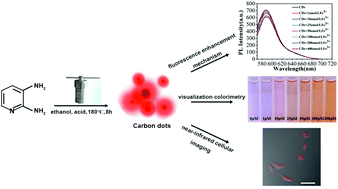Orange red-emitting carbon dots for enhanced colorimetric detection of Fe3+
Abstract
Carbon dots (CDs) have demonstrated considerable potential for use in sensing and bioimaging applications based on their unique intrinsic properties. However, CDs have typically been used as fluorescence sensors, as opposed to indicators, based on their ultraviolet absorption and discoloration performance. In this study, orange red-emitting CDs with a high quantum yield (QY) of 53% were constructed from 2,3-diaminopyridine via solvothermal synthesis. Different from the fluorescence quenching behavior reported previously, the constructed CDs demonstrated a unique character in their ultraviolet absorption and fluorescence emission in the presence of Fe3+. The color of the CD solution varied from mauve to orange following the addition of Fe3+ at concentrations exceeding 1 μM, which enabled these CDs to be used in the determination of the presence of Fe3+ in lake water. In addition, due to their negligible cytotoxicity, good solubility, and adequate dispersity, an outstanding cellular probe with near-infrared fluorescence was established. Overall, this study presents a unique CD-based sensor, details its fluorescence mechanism, visual colorimetry, and ultraviolet absorption variations, and confirms its applicability in near-infrared cellular imaging and environmental analyses.



 Please wait while we load your content...
Please wait while we load your content...